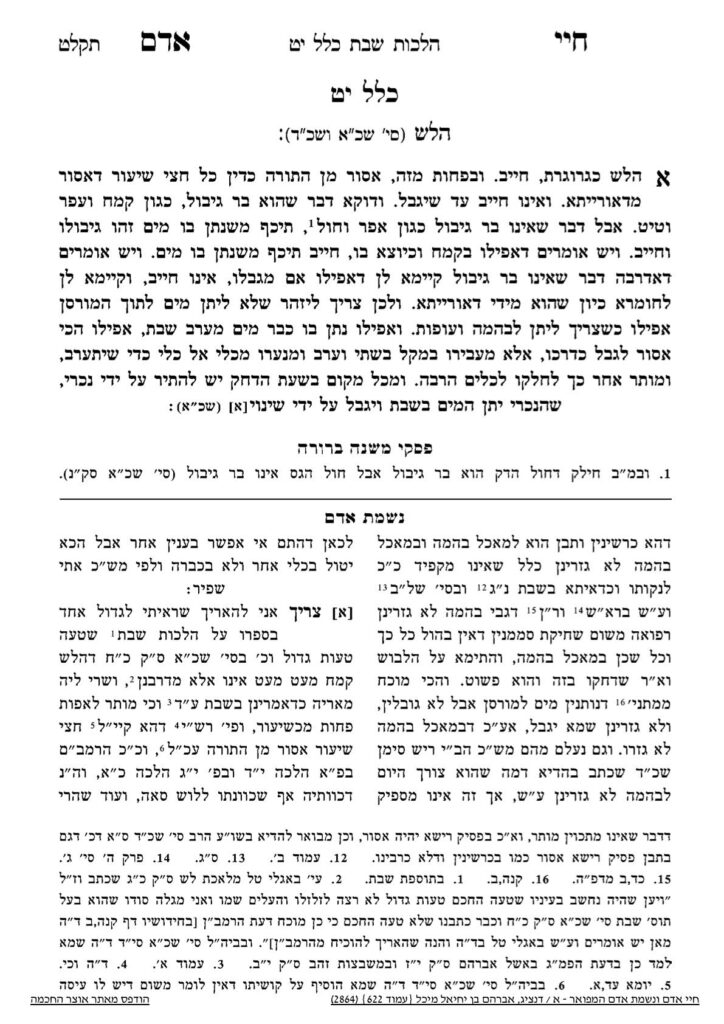We are continuing in siman 1, where the Chayei Adam is discussing preparing bran for animals. We learned that even if one adds water before Shabbos, it cannot be mixed on Shabbos in a normal fashion. One must employ a shinui. The Chayei Adam described two methods, either pouring between two containers, or a criss cross method.
The Chayei Adam continues, and writes that once a person has employed a shinui, they can divide the mixture into multiple smaller containers. It is not clear to Rabbi Reingold what is the chiddush of this line, but it could be he is alluding to the principle that when it comes to feeding animals on Shabbos, one should minimize the tircha (effort). Shabbos is a day of rest, so one is meant to minimize–to whatever extent possible–the amount of work they perform. The Ramban understands that this is a din deoraysa based on the word Shabasson. It is possible that the Chayei Adam means that technically speaking, it would require less work to skip the larger container and only use smaller containers. Nevertheless, the Chayei Adam is saying that it is muttar to begin in a large container and subsequently pour it into smaller containers, even though there is technically an extra step involved in that process.
The Chayei Adam continues, and writes that if one did not add water to the bran before Shabbos, there is a concern that since it is not a bar gibul, the mere placement of the water constitutes losh. However, since there is an opinion that bran is a bar gibul, according to Rabbi Yosi Bar Rabbi Yehuda, the first step of merely placing the water is not an issue. Therefore, one can ask a non-Jew in situations of need. Alternatively, according to the Rambam it would be an issur derabanan, which would be a shvus d’shvus b’makom hefsed (not feeding animals), and it would be muttar as well.
Once the non-Jew has performed the first stage, the second stage of mixing the items can be performed with a shinui, as we have learned.
We are moving on to siman 2, and will begin with an introduction. The Gemara discusses the idea that, according to Rebbi, a shinui may be effected by changing the order of the ingredients. For example, if one normally places the water first, and then adds powder, one should place the powder first and then add water. This change is not a significant shinui, and is considered a lower level shinui than actions such as stirring in a crisscross motion or shaking the container. Therefore, we differentiate between a belilah raka, a batter-like, pourable mixture, and belilah avah, and thicker mixture. A belilah raka is assur miderabanan, and therefore a lower level shinui such as changing the order of the ingredients is sufficient. A belilah avah is assur mideoraysa, and requires a higher level shinui. If a case of significant, pressing need, one may be able to rely on a lower level shinui even for a shinui deoraysa. We will clarify this later.
Summary
Losh is muttar with a shinui. Examples of shinui would be pouring the mixture between two containers, or mixing it in a shesi va’arev pattern
Therefore, when making animal bran, if the water was not mixed in before shabbos, a shinui must be employed when mixing the items together.
Nevertheless, there is not a concern for tircha should one decide to mix the bran in a large bowl and subsequently divide it up into small bowls.
If one did not add water to the bran before Shabbos, they can ask a non-Jew to do so in situations of need.
A lower level shinui will only work for a belilah raka, because it is an issur derabanan. A belilah avah requires a more significant shiui since it is assur mideoraysa.



